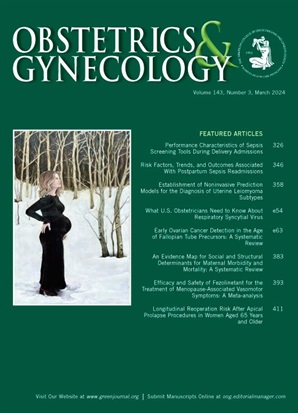Small-for-Gestational-Age Birth Weight Risk Stratification Using First-Trimester Fetal Cardiac Parameters.
IF 4.7
2区 医学
Q1 OBSTETRICS & GYNECOLOGY
引用次数: 0
Abstract
OBJECTIVE To apply unsupervised machine learning techniques to first-trimester fetal cardiac data to enhance early risk stratification of small-for-gestational-age (SGA) birth weight. METHODS This was a prospective cohort study that enrolled patients up to 13 6/7 weeks of gestation without fetal, umbilical cord, or placental abnormalities. At the first-trimester ultrasonogram, the chest area, heart area, ventricular inlet lengths, and spectral and color Doppler of the atrioventricular valves were assessed. An unsupervised machine learning technique, k-means clustering, was applied to sort fetuses into risk groups for SGA birth weight, defined as a birth weight less than the 10th percentile for gestational age. Candidate variables were selected with regression analyses, and the elbow method was used to determine the optimal number of clusters. Cumulative rates of outcomes were plotted with Kaplan-Meier analysis, and model performance was tested with area under the curve values with repeated cross-validation. RESULTS Six hundred seventeen pregnancies were included in the analysis, with 45 (7.3%) patients delivering a neonate with SGA birth weight. z-scores of the chest area (P=.031) and tricuspid valve E/A ratio (P<.001) showed an independent association with SGA birth weight and were used in the clustering algorithm. An unsupervised machine learning algorithm blinded to the outcome identified three risk clusters: low (n=202), intermediate (n=217), and high (n=198). The rates of SGA birth weight (1.2%, 5.4%, and 14.4%, respectively, P<.001) and nonreassuring fetal heart rate tracings (3.6%, 5.4%, and 8.6%, respectively, P=.039) differed significantly among the three risk clusters. Area under the curve values of the model in cross-validation samples were 0.71 (95% CI, 0.64-0.77). Using the low-risk cluster as a threshold, the model specificity was 95.5% and sensitivity was 35.0% for ruling out SGA birth weight. The negative predictive value for ruling out SGA birth weight was 99.0%. CONCLUSION Unsupervised machine learning of first-trimester fetal cardiac parameters can effectively stratify risk for SGA birth weight.使用早期妊娠胎儿心脏参数进行小胎龄出生体重风险分层。
目的将无监督机器学习技术应用于早期妊娠胎儿心脏数据,以增强小胎龄(SGA)出生体重的早期风险分层。方法:这是一项前瞻性队列研究,纳入妊娠13 6/7周无胎儿、脐带或胎盘异常的患者。在妊娠早期超声检查中,评估胸面积、心脏面积、心室入口长度以及房室瓣膜的光谱和彩色多普勒。一种无监督的机器学习技术,k-means聚类,被应用于将胎儿分类到SGA出生体重的风险组中,SGA出生体重的定义是出生体重小于胎龄的第10个百分位数。通过回归分析选择候选变量,采用肘部法确定最佳聚类数。结果累积率用Kaplan-Meier分析绘制,曲线下面积用反复交叉验证检验模型性能。结果617例妊娠纳入分析,其中45例(7.3%)分娩的新生儿出生体重为SGA。胸面积z-score (P= 0.031)和三尖瓣E/A比值(P< 0.001)与SGA出生体重独立相关,并用于聚类算法。一种不考虑结果的无监督机器学习算法确定了三个风险集群:低(n=202)、中(n=217)和高(n=198)。三个风险组的SGA出生体重率(分别为1.2%、5.4%和14.4%,P< 0.001)和不可靠的胎心率(分别为3.6%、5.4%和8.6%,P= 0.039)差异有统计学意义。交叉验证样本中模型曲线下面积为0.71 (95% CI, 0.64-0.77)。以低风险聚类为阈值,排除SGA出生体重的模型特异性为95.5%,敏感性为35.0%。排除SGA出生体重的阴性预测值为99.0%。结论无监督机器学习早期妊娠胎儿心脏参数可有效分层SGA出生体重风险。
本文章由计算机程序翻译,如有差异,请以英文原文为准。
求助全文
约1分钟内获得全文
求助全文
来源期刊

Obstetrics and gynecology
医学-妇产科学
CiteScore
11.10
自引率
4.20%
发文量
867
审稿时长
1 months
期刊介绍:
"Obstetrics & Gynecology," affectionately known as "The Green Journal," is the official publication of the American College of Obstetricians and Gynecologists (ACOG). Since its inception in 1953, the journal has been dedicated to advancing the clinical practice of obstetrics and gynecology, as well as related fields. The journal's mission is to promote excellence in these areas by publishing a diverse range of articles that cover translational and clinical topics.
"Obstetrics & Gynecology" provides a platform for the dissemination of evidence-based research, clinical guidelines, and expert opinions that are essential for the continuous improvement of women's health care. The journal's content is designed to inform and educate obstetricians, gynecologists, and other healthcare professionals, ensuring that they stay abreast of the latest developments and best practices in their field.
 求助内容:
求助内容: 应助结果提醒方式:
应助结果提醒方式:


